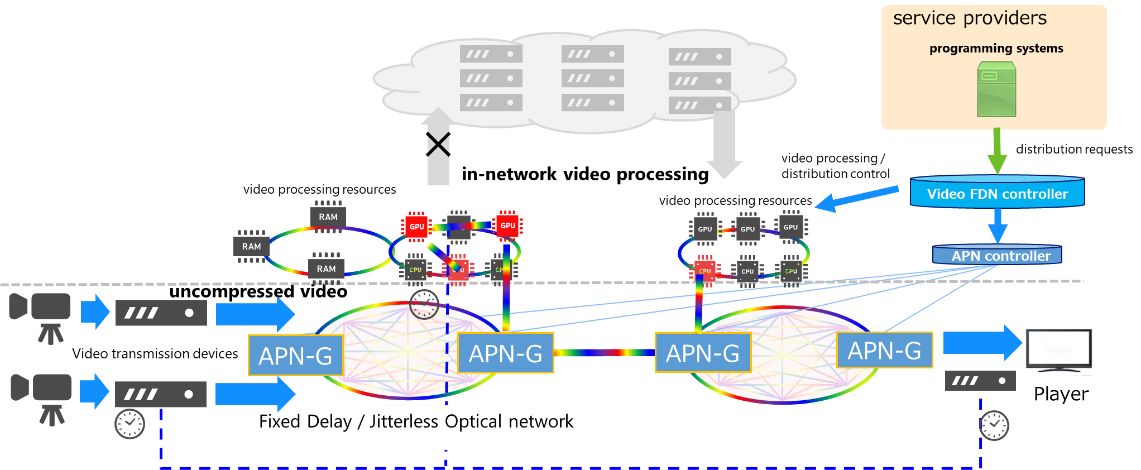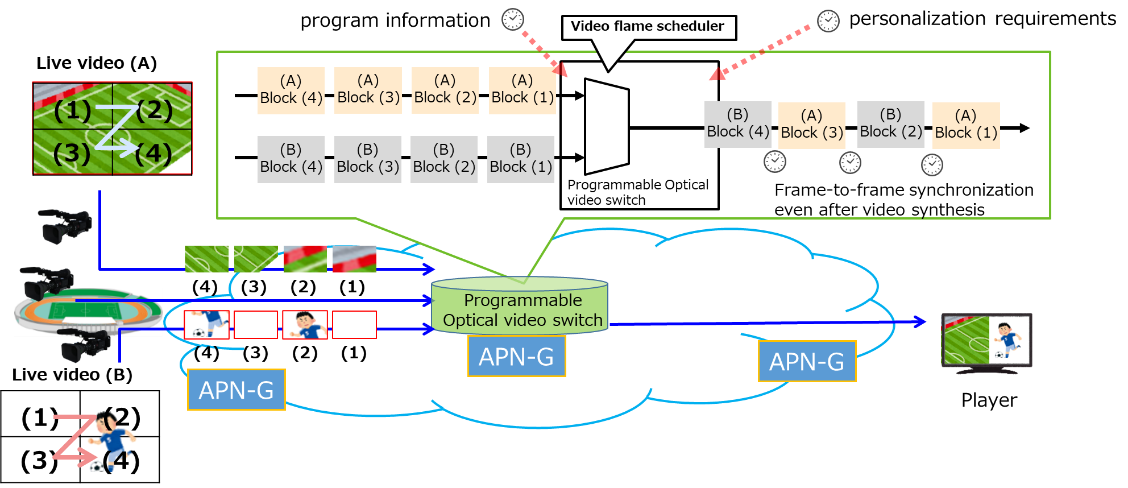Microsoft ends support for Internet Explorer on June 16, 2022.
We recommend using one of the browsers listed below.
- Microsoft Edge(Latest version)
- Mozilla Firefox(Latest version)
- Google Chrome(Latest version)
- Apple Safari(Latest version)
Please contact your browser provider for download and installation instructions.
June 1, 2023
Nippon Telegraph and Telephone Corporation
Demonstration of the Basic Functionality of a New End-to-End Optical Video Distribution Architecture Using APNs
~ Toward the Realization of Low-Latency Live Distribution Connecting Multiple Points on Demand via IOWN ~
Nippon Telegraph and Telephone Corporation ((NTT), President and CEO: Akira Shimada) has demonstrated the basic functions of an end-to-end optical video distribution technology for next-generation video distribution using APNs in the IOWN (*1) era. The APN-based end-to-end optical video distribution architecture will contribute to the realization of low-latency live distribution connecting multiple points on demand.
1. Background
In recent years, remote production using cloud services has been widely used for video and program production by broadcasters and OTT service providers (*2). This allows program production to be carried out by consolidating video materials, thereby streamlining the production process compared with the traditional practice of program production at locations across the country. On the other hand, video data is becoming increasingly high-definition and large in volume (4K and 8K), and further increases are expected in network costs for consolidating materials, cloud service costs associated with increased processing volume, and power consumption for a range of systems.
Against this backdrop, NTT aims to solve these issues through an end-to-end optical video distribution architecture that connects directly to the optical transmission network by chaining (*3) resources such as GPUs that perform video processing with optoelectronic convergence devices.
2. End-to-end optical video distribution architecture with APN
The end-to-end optical video distribution architecture uses resources such as CPU, GPU, and memory on the APN as video processing resources (Fig. 1). These resources are interconnected at optical wavelengths by optoelectronic fusion devices, and the video FDN controller (*4) controls resource allocation and interconnection between resources in accordance with the scale and content of the required video processing. These video processing resources are directly connected to the APN device (APN-G) (*5) via an optical path, connecting the input video material to the output to the player via an end-to-end optical path. This enables optical communication for video data communication and resource-to-resource connection, resulting in ultra-low latency, high bandwidth, and low power consumption compared with conventional video distribution systems that use electrical processing. In addition, the video FDN controller works with service providers' programming systems, etc., to provide network resources and video processing resources on demand in response to video distribution requests.
The elementary technologies for the basic functions of this architecture include (1) in-network video processing technology and (2) dynamic, programmable material path switching technology. The (1) in-network video processing technology is located in the programmable optical video switch deployed on the APN and enables video processing and editing on the network by processing each video block (Fig. 2). This technology rewrites the communication data flowing over the network for each video block on the basis of the user's programming information and personalization requirements for multiple video materials. Thus, video processing such as switching and compositing can be performed on network equipment without using general purpose switches or other video equipment, and video processing is possible without converting video data into video signals or file formats. (2) Programming-based dynamic material transmission path switching technology optimizes the use of network resources by controlling network paths/routes and allocating resources on demand in connection with necessary video processing on the basis of programming information from the service provider. By dynamically controlling video transmission and distribution between multiple points using this technology, video distribution can be realized that seamlessly connects different types of videos with low latency.
 Figure 1 End-to-End Optical Video Distribution Architecture
Figure 1 End-to-End Optical Video Distribution Architecture
 Figure 2 Overview of in-network video processing technology
Figure 2 Overview of in-network video processing technology
3. Joint demonstration of linear video transmission platform
NTT and NHK Science & Technology Research Laboratories (STRL) jointly implemented some of the results of the dynamic material transmission path switching technology in the basic functions of the linear video (*6) distribution platform and conducted operational verification. In this joint verification, NTT and NHK STRL jointly constructed a verification environment combining an optical path network implementing a part of NTT's dynamic material transmission path switching technology and NHK STRL's video distribution platform technology and conducted an operational verification of the basic functions of the linear video distribution platform.
In the verification, NTT's dynamic material transmission path switching function enabled on-demand reservation of optical paths on the basis of program information created by broadcasters. By controlling the opening and closing of the optical path network on demand, it was confirmed that efficient network utilization is possible for transmitting large-volume, high-definition video material. In addition, we verified that NHK STRL's video distribution infrastructure technology can seamlessly switch programs with frame accuracy, switch the video to be distributed in accordance with the viewer's regional information, and apply superimposed functions such as weather symbols to the video material. We also confirmed that low-latency, end-to-end distribution from camera to player can be achieved by combining network and video distribution infrastructure technologies. This initiative was showcased at NHK STRL OPEN HOUSE 2023, which was held from June 1 to 4, 2023 (*7).
4. Future developments
To further advance the sophistication of APN, NTT will continue to study ways to combine video processing technologies that can be implemented within the network on the basis of the verification environment and the verification results of this achievement and will continue to establish technologies to realize new and unprecedented video experiences.
Glossary
*1 IOWN (Innovative Optical and Wireless Network) is a network and information processing infrastructure including terminals that can provide high-speed, large-capacity communications, and vast computing resources by utilizing innovative technologies centered on optical technology. IOWN will contribute to the realization of an even more affluent society by creating a variety of services and new value in not only telecommunications but also a wide range of other fields.
URL:https://www.rd.ntt/e/iown/index.html
*2Over-the-top (OTT) service providers are those that offer content and services such as messaging, voice calls, and video distribution without relying on telecommunications carriers or Internet service providers (ISPs).
*3Chaining is a method by which multiple network resources and video processing resources are chained together in a bead-like fashion and the necessary processing is performed by multiple processing devices.
*4Function Dedicated Network (FDN): FDN is a function-specific dedicated network that provides flexible and dynamic control over the IOWN's APN with the goal of dramatically improving the ICT user experience.
*5APN-G (APN Gateway): APN-G is one of the devices that make up an APN and has functions such as controlling wavelength allocation and line collection.
*6 Linear video distribution is a method of distributing live and recorded video in accordance with a pre-planned schedule (programming), with distribution and switching at specified times.
*7 NHK STRL OPEN HOUSE 2023 official website:https://www.nhk.or.jp/strl/english/open2023/
Media Contact
NTT Information Network Laboratory Group
Planning Department, Public Relations Section
nttrd-pr@ml.ntt.com
Information is current as of the date of issue of the individual press release.
Please be advised that information may be outdated after that point.
NTT STORY
WEB media that thinks about the future with NTT









